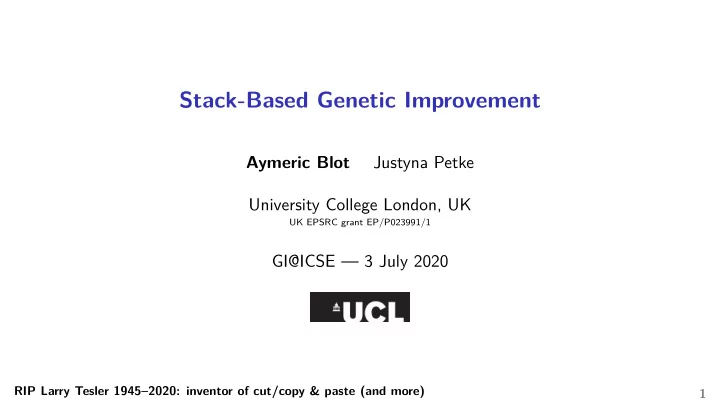

Stack-Based Genetic Improvement Aymeric Blot Justyna Petke University College London, UK UK EPSRC grant EP/P023991/1 GI@ICSE — 3 July 2020 RIP Larry Tesler 1945–2020: inventor of cut/copy & paste (and more) 1
In a Nutshell Solution representation in GI: ◮ Software itself ◮ Diff patch ◮ Sequence of edits Current GI edits: Proposed GI edits: ◮ Delete(l) ◮ Cut(l) ◮ Replace(l1, l2) ◮ Copy(l) ◮ Insert(l1, l2) (x2) ◮ Paste(l) (x3) ◮ ... ◮ ... Petke et al., IEEE Transactions on Evolutionary Computation, 2018 (literature review) 2
Why? Are Current Edits Not Good Enough? Insert(1, 2) Delete(3) Advantages: ◮ Focus on the changes only ◮ Easy creation/mutation/crossover ◮ Close to human understanding “i” 1 2 “d” 3 ∅ Limitations: ◮ Complex high granularity “i” “d” 1 3 2 recombination ∅ ◮ Type constraints op fault fix Oliveira et al., Empirical Software Engineering, 2018 (decoupled representation) 3
High Granularity Recombination op fault fix op fault fix crossover repair repair repair Example: One Point Across All Subspaces ◮ Issue: invalid, incomplete genes ◮ Solution: individual caches Oliveira et al., Empirical Software Engineering, 2018 (high granularity crossovers) 4
Ensuring “Type” Validity Consistency is important! ◮ Replace([statement], [statement]) will work ◮ Replace([condition], [condition]) will work ◮ Replace([condition], [statement]) will fail horribly Possible solutions? ◮ Disable high granularity recombination ◮ Multiple decoupled sub-representations ◮ Any other complex bespoke mechanism 5
Equivalent Stack-Based Edits Initial state: Cut(1) Copy(2) Paste(3) Paste(4) Copy(5) � empty patch + empty stack: [ ] Cut: Cut(1) Copy(2) Paste(3) Paste(4) Copy(5) � Delete(1) + stack: [ 1 ] Copy: Cut(1) Copy(2) Paste(3) Paste(4) Copy(5) � Delete(1) + stack: [ 1, 2 ] Paste: Cut(1) Copy(2) Paste(3) Paste(4) Copy(5) � Delete(1) Replace(3, 2) + stack: [ 1 ] Final patch: Cut(1) Copy(2) Paste(3) Paste(4) Copy(5) → Delete(1) Replace(3, 2) Replace(4, 1) + discarded stack 6
“It Just Works” TM Insertion? ◮ replace = paste in place ◮ insert before = paste before ◮ insert after = paste after High granularity recombination? ◮ Simple “non-decoupled” crossover ◮ Full decoupling with Target(l) (x3), Copy(l) , Cut(l) , Paste(l) Type validity? ◮ Pop and push to type-specific stacks Spector and Robinson, Genetic Programming Evolvable Machines, 2002 (Push language) 7
Conclusion Idea: ◮ Replacement set of edits ◮ Equivalent, backward compatible Advantages: ◮ Same features but simpler ◮ Built-in memorisation mechanism ◮ Automatic type separation (multiple stacks) 8
Selected References Vinicius Paulo L. Oliveira, Eduardo Faria de Souza, Claire Le Goues, and Celso G. Camilo-Junior. Improved representation and genetic operators for linear genetic programming for automated program repair. Empirical Software Engineering , 23(5):2980–3006, 2018. Justyna Petke, Saemundur O. Haraldsson, Mark Harman, William B. Langdon, David R. White, and John R. Woodward. Genetic improvement of software: A comprehensive survey. IEEE Transactions on Evolutionary Computation , 22(3):415–432, 2018. Lee Spector and Alan J. Robinson. Genetic programming and autoconstructive evolution with the push programming language. Genetic Programming and Evolvable Machines , 3(1):7–40, 2002. + 1
Recommend
More recommend